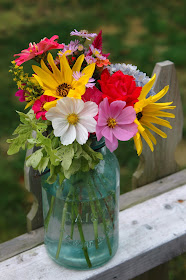Planting soil is the foundation for a healthy, beautiful garden. Before you can even dream of your first harvest of cut flowers you want to make sure your soil is prepped and ready for seeds and seedlings. Not all dirt is created equal. But you already knew that! The needs of the plants you intend to grow, as well as the region you are gardening in will determine what kind of soil mixture will be best for nourishing your cut flowers.
A good quality planting should contain the following ingredients:
- Nitrogen to promote leafy, green growth. If nitrogen content is too high, it can delay flowering plants and vegetables.
- Phosphorous for encouraging strong root systems and helps increase fruiting.
- Potassium for overall plant strength and flowering.

Raised Bed Gardening
When my raised beds were first constructed I filled them with an organic horticultural mix that I order in by the yard from our local landscape supply company. It comes premixed with the ingredients listed below and goes by the name, Horticultural Mix. Other companies might call it Premier Soil Mixture.
- Peat moss – Neutral, nutrient rich peat, excellent for retaining moisture
- Organic Compost – Neutral, high organic, nutrient rich compost
- Top Soil – Variable PH naturally occurring loam material, with valuable nutrients
- Sand – Neutral medium, excellent for creating a soil that will drain excess water and allow air and roots to pass through it
At the end of the season, I top off all of the raised beds with a layer of dried leaves where they are left to compost over the winter months. Come springtime I remove the driest leaves from the top. Using a shovel, I turn in the decomposed leaves to add more rich organic matter to the soil prior to planting my first seeds of the new season.
My established borders always get a top dressing of rich compost material such as DE-composed leaves, grass clippings, and some composted top soil straight out of the chicken run. ( make sure it has had a chance to soak into the floor of the chicken run for a few months before adding it to the garden) I generally spread this mixture on top of any area that is cleared and ready for planting new perennials or shrubs. Once the area has been covered dig it into the area about 6- 8 inches deep.
 |
| Early June border |
Be aware of your climate, how much rainfall you get and the content of the soil your are working with and make adjustments from there. Pay attention to the growing needs of each plant and beyond that, give your plants lots of love and care and cross your fingers for beautiful blooms. Whether you're planting acres and acres of flowers or farming your garden like me, there's will always be surprises!






No comments:
Post a Comment
Seeds to share? Scatter here...